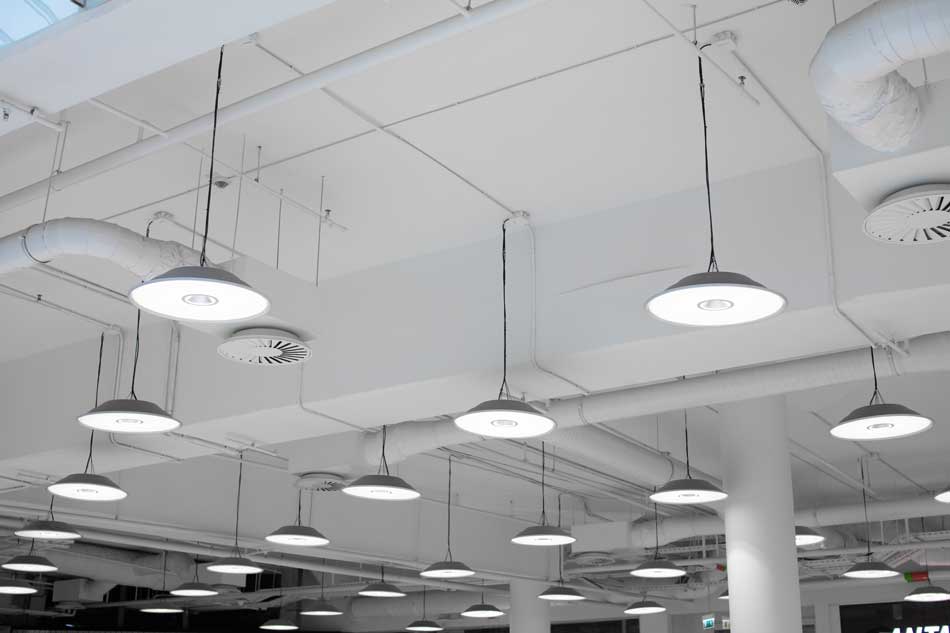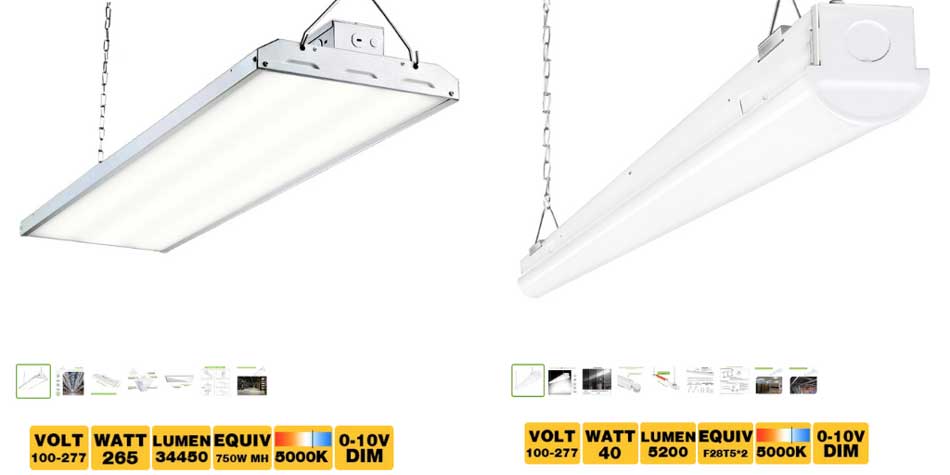When I was starting to look into upgrading my garage lighting, the “experts” said that I needed to have separate fixtures and T8 fluorescent lamps or LED bulbs.
I found a lot of fixtures called “high bay lights.”
If you’ve never heard that term before, you’re not alone.
So, what is high bay vs low bay lighting? Which should you use in a residential garage?
As I was digging into the answer, I found three great reasons you never want to use high-bay lights in your garage at home.
First, let’s talk about the difference between high-bay and low-bay lighting.

High Bay vs Low Bay Lighting: What’s the Difference?
For most people, it’s difficult to tell the difference between high bay and low bay lighting. You’ll usually see references to ‘high-bay lights’ but rarely low-bay lights.
Sometimes called ‘warehouse lights,’ ‘high-bay- lights are designed for use in rooms with a ceiling higher than 20’ tall. They typically have a tighter beam angle and reflectors to focus the light the longer distance toward the warehouse floor. Those same strengths make them poorly suited for residential garages.
By contrast, low-bay lights are designed to be used in rooms with a ceiling height under 20′ tall. Low bay light fixtures lack reflectors, resulting in a wider beam angle to spread light out rather than focus it.
So, what’s wrong with using high bay light fixtures with a low ceiling height?
Well, there are several reasons why low bay lights are better for your home garage.
3 Reasons NOT To Use High Bay Lights In Your Garage
Reason #1: They Cast Shadows Where You Don’t Want Them
The biggest reason not to use a high-bay garage light fixture is that it will cast shadows where you don’t want them.
Remember that these lights were designed to be used in industrial and commercial spaces, like warehouses and retail stores.
In a warehouse, you want powerful light focused on the floor. You don’t necessarily care about casting shadows on the ceiling because that’s not where people and products will be.
This refers to something called the beam angle.
A light’s beam angle determines if it’s focused into a narrow beam (like a spot-light) or spread wide to cover a greater distance.
Take a look at this picture.
The light fixture on the left has a 30° beam angle, while the fixture on the right has a 120° beam angle.

The bulb on the left side projects concentrated light that extends farther away from the bulb.
However, this causes shadows to form higher up on the wall.
On the right side, the wide beam angle doesn’t extend the focused part of the light as far down, but fewer shadows are near the light.
Here’s another example.
This high bay light has a narrow beam angle, focusing its beam more-or-less straight down.

Traditional high-bay commercial lighting typically uses powerful, more focused beam angles because the light has to reach the floor from the high ceilings.
In contrast, a residential garage with lower ceilings needs to spread out the light to get even coverage over a wider area.
That makes high-bay LED lights a poor choice for residential garages with low ceiling height.
Reason #2: High-Bay Lighting Uses More Power
In an apples-to-apples comparison (more on that in a second), a high-bay LED light will use more power than a low-bay light.
One important thing to note: We’re comparing raw power consumption, not energy efficiency. Energy efficiency is usually relatively constant in a manufacturer’s lineup.
A high-bay light will use more power than comparable low-bay lights. This is because it’s designed to output more light over a greater distance (back to the beam angle problem).
For example, the Hykolity LED shop lights that I reviewed output 5200 lumens while using only 40 watts of power. That’s 130 lumens per watt.
But Hykolity’s high-bay LED fixture that outputs 29,250 lumens while using 223 watts still produces the same 130 lumens per watt of power.
Sure, it outputs more lumens of light overall, but they’re all concentrated in one place.
Remember, residential garage lighting aims to evenly spread the light output across the floor rather than a more focused beam in one area.

High Voltage: High-bay lights can output a ton of light, which requires a lot of power. Some fixtures require up to 480 volts – four times that of a typical house.
Even if you’re looking for intense light, you may not be able to install these lights without significant modifications to your house.
Reason #3: High-Bay Lights Cost More (Initially and Ongoing)
Determining costs is a challenge. Something that may cost more initially may actually be cheaper in the long run.
Take Hykolity, for example. They make LED high bay LED shop lights that cost $135 per 4′ section, while their 4′ LED shop lights cost around $40.
The same goes for T8 light fixtures. High bay LED shop lights typically cost 20%-30% more than similar low bay fixtures.
High-bay lights not only cost more initially but also cost more to operate. This is a lose-lose situation for most homeowners.
Combined with the higher cost of running a 225-watt fixture rather than a 40-watt fixture…suddenly, that high-bay fixture is a massive drain on your monthly utility bill.
High Bay vs Low Bay Lighting: The Verdict
I’m not trying to dump on high-bay lights because they have their purpose.
They’re designed for warehouses – not your garage.
The difference between high bay vs low bay lights is clear. With the tighter beam angle, higher initial cost, and overall operating costs, high bay lighting isn’t designed for home use.
Wondering what garage lighting to buy? I tested some of the highest-rated shop lights against each other to find the best LED shop lights. Check out my super-detailed guide to garage lighting for more tips!
